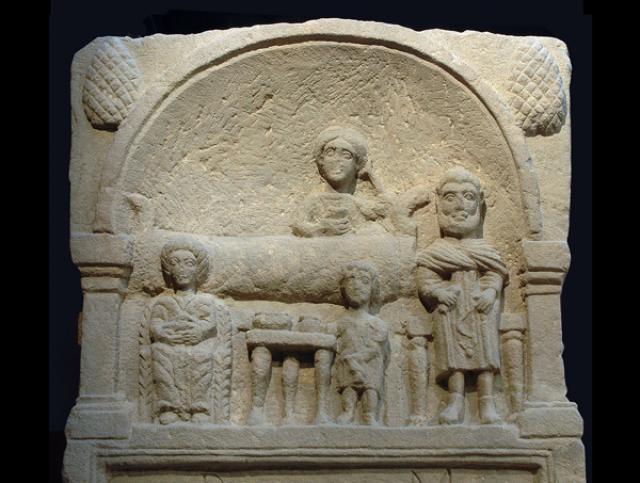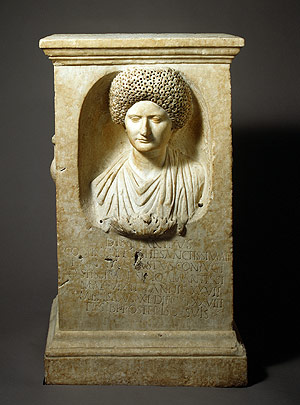Death in Roman Times
The Romans and early deaths
|
|
Medicine in Roman times was a very basic affair and relied on herbs and the will of the gods, so it was a common event for a family to lose an infant child early in life. The Romans had accepted this, and knew the risks of a child surviving to adulthood were great. The exact figure is not know, though a good estimate is that less then 50% of children born lasted beyond the first couple of years of life. This was a universal concept and does not appear to be restricted to class. Children from a wealthy family were just as much at risk as those from a poor family. It all came down to disease, the lack of knowledge of medication. The Romans did not have any idea what caused illnesses and did not know about bacteria and viruses. So most of the deaths were a mystery to them. To them, it was a fact of life and the will of the gods.
The funeral itself
If a child died, then the body would be washed thoroughly to cleanse him/her for the afterlife and then laid out in the main hall of the house. A branch of cypress or pine was placed outside the house to let passers by know that there had been a death in the household. This was a way of asking for respect from those who were walking past. On seeing the branch, people passing would stop talking and try to pass the house as quietly as possible.

The funeral would take place the following evening, usually after dark where the body would be buried or cremated in a small, private ceremony attended only by the family.

Noble families did not adhere to this tradition of quiet funerals and made the occasion an excuse for a grand display that was so common of the upper classes ego inspired ceremonies. The funeral would be announced by a herald, whose purpose it was to relate to the townspeople the time and date of the funeral. The cortege would be led through the town accompanied by pipers, horn and flute players and torch bearers. They would even hire professional mourners to add to the open expression of grief.
Polybius wrote about one such funeral.
Whenever a distinguished man dies, he is carried, during the course of the funeral, into the Forum, to the public speakers' platform: the corpse is sometimes conspicuous in an upright position, and more rarely reclined. When the people have gathered, an adult son, or some other relative, mounts the platform and makes a speech on the dead man's virtues and the successful achievements of his lifetime. As a result when the deeds are recalled to their minds and brought before their eyes these spectators are moved to such sympathy that the death seems to be not a private affair for the mourners, but a public loss, affecting everyone. Next, after the body has been buried, they place the image of the dead man in a most conspicuous place in the house, in a wooden shrine. The image is a mask which resembles the deceased very closely, both in features and complexion. These images are displayed at public sacrifices, and when any important member of the family dies, they are carried in the funeral procession, and are worn by men who seem to bear the closest resemblance to the original in build and appearance. These mask-carriers put on togas with a purple border, if the mask's original was a consul or a praetor, an all-purple toga if he was a censor, and a toga embroidered with gold if he had celebrated a triumph. The mask-carriers ride in chariots in the funeral procession with all the trappings and insignia to which the rank of the original entitles them, and when they arrive at the Forum they sit down, in order of rank, on ivory chairs. There could hardly be a more inspiring spectacle, for who would not be stirred by the sight of images of men, renowned for their excellence, all together and seeming to be alive and breathing?
An average family would bury their dead in a grave, or cremate the body. If a body was cremated, then the ashes were kept by the family, buried, or, in the case of poor families, have them cast into a communal pit. The nobility would bury theirs by a road leading out of the city and make a great monument to be seen by all. It was the custom at funerals to cut off the head of the deceased just before it was lowered into the grave. The head was then placed between the legs. In doing this, the Romans believed that the spirit would be freed from the body and so be able to go on to another existence.
 Death was seen as final and an end, as the epitaph reproduced here demonstrates.
Death was seen as final and an end, as the epitaph reproduced here demonstrates.
Stranger, my message is short. Stand here and read it through. Here is the ugly tomb of a lovely woman. Her parents named her Claudia. She loved her husband with all her heart. She bore two sons. One of these she leaves on earth, the other she has buried under the earth. She was charming in conversation, yet gentle in manner. She kept house, she made wool. That is all I have to say. Go your way.




















